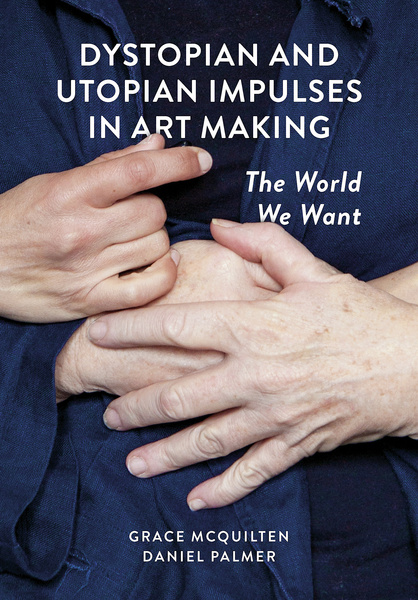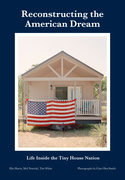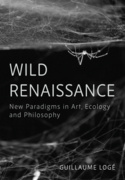Dystopian and Utopian Impulses in Art Making (Book)
The World We Want
Explores a variety of artistic responses to contemporary global crises including climate emergency, global and local inequalities and the COVID-19 pandemic. Focuses on how artistic production is adapting and offers a series of artistic, curatorial considerations and pedagogical proposals for the world we live in and the one we want. 115 b&w illus.
Edition
Contemporary art has a complex relationship to crisis. On the one hand, art can draw us toward apocalypse: it charts unfolding chaos, reflects and amplifies the effects of crisis, shows us the dystopian in both our daily life and in our imagined futures. On the other hand, art’s complexity helps fathom the uncertainty of the world, question and challenge the order of things, and allows us to imagine new ways of living and being – to make new worlds.
This collection of written and visual essays includes artistic responses to various crises – including the climate emergency, global and local inequalities and the COVID-19 pandemic – and suggests new forms of collectivity and collaboration within artistic practice. It surveys a wide variety of practices, oriented from the perspective of Australia, New Zealand and Asia. Art making has always responded to the world; the essays in this collection explore how artists are adapting to a world in crisis.
The contributions to this book are arranged in four sections: artistic responses; critical reflections, new curatorial approaches and the art school reimagined. Alongside the written chapters, three photographic essays provide specific examples of new visual forms in artistic practice under crisis conditions.
The primary market for the book will be scholars and upper-level students of art and curating at both undergraduate and postgraduate level. Specifically, the book will appeal to the burgeoning field of study around socially engaged art.
Beyond the academic and student market, it will appeal to practicing artists and curators, especially those engaged in social practice and community-based art.
Grace McQuilten is a senior lecturer and leader of the Contemporary Art and Social Transformation Research Group at RMIT University, Australia. Grace completed her Ph.D. in art history at the University of Melbourne in 2008. In 2016, she published the book Art as Enterprise: Social & Economic Engagement in Contemporary Art (co-authored with Dr Anthony White, IB Tauris,2016) and in 2011 Art in Consumer Culture (Ashgate Publishing, 2011). She has curated major exhibitions at venues including the Ian Potter Museum of Art, Immigration Museum of Victoria and National Gallery of Victoria and has presented public art projects and events for festivals such as the Sustainable Living Festival, the State of Design Festival, Craft Cubed and Melbourne Spring Fashion Week.
Daniel Palmer is associate dean of Research and Innovation in the School of Art at RMIT University. Palmer holds a Ph.D from the University of Melbourne and his research and professional practice focuses on contemporary art and cultural theory, with a particular emphasis on photography, digital media and art and politics. Palmer’s book publications include Installation View: Photography Exhibitions in Australia 1848–2020 (Perimeter Editions 2021) with Martyn Jolly; Photography and Collaboration: From Conceptual Art to Crowdsourcing (Bloomsbury 2017); Digital Light (Open Humanities Press, 2015), edited with Sean Cubitt and Nathaniel Tkacz; The Culture of Photography in Public Space (Intellect 2015), edited with Anne Marsh and Melissa Miles; Twelve Australian Photo Artists (Piper Press, 2009), co-authored with Blair French; and Photogenic (Centre for Contemporary Photography, 2005).
List of Figures
Acknowledgements
Introduction: Contemporary Art and Crisis Grace – McQuilten and Daniel Palmer
PART 1: ARTISTIC RESPONSES
1. Beyond the Dystopia-in-Progress: Rehearsing an Indigenized Future ‘Australia’ Through Public Art – Robert E.Walton and Claire G. Coleman
2. Weentayoothan – Which Way? – Vicki Couzens
3. The Space in Between Us: Photographic Portraiture, Social Distancing and Touch – Cherine Fahd
4. A Melting Landscape: Mapping the Eco-Acoustics of the Swiss Alps – Philip Samartzis
5. Survivalist Samplers: Restoring Sampling Traditions and Utopian Perspectives – Sera Waters
6. Presenting the News Anew – Alison Alder, Marian Crawford and Richard Harding (aka The News Network Project Australia: AA & MC & RH)
7. Practicing Utopias – Sophia Cai, Bigoa Chuol, Gabriela Georges, John Mashar with Tania Cañas and Bruno Catalán
Visual Essay 1: Inland Sea – Heather Hesterman
PART 2: CRITICAL REFLECTIONS
8. The Art of Giving Up: Contemporary Artists and Domestic Violence – Madeleine R. Clark
9. Refugees, Neighbours and the Question of Empathy: Jakkai Siributr’s There’s No Place – Zara Stanhope
10. The Thorny Question of Art and Economy – Nancy Mauro-Flude and Kate Rich
11. Imagine a World Without Zoonotic Viruses – Keely Macarow
12. Writing About Art from Behind an Inclined Rock (A Geological Allegory for the Third Millennium) – Susan Ballard
Visual Essay 2: Lisbon Dreaming – Clare McCracken
PART 3: NEW CURATORIAL APPROACHES
13. Amor Mundi: Towards a Curatorial Ethics for Climate Crisis – Tara McDowell
14. The Gentle Activism of ‘Bruised Food’: Art and Curation in Times of Crises – Marnie Badham and Francis Maravillas
15. Hong Kong’s Utopian Dream: Art, Nostalgia and Identity – Kelly Ka-Lai Chan
16. Thinking With, and Acting From, This Place: Caring In and Through Our Practices – Jacina Leong
Visual Essay 3: Scribble Me This … – Benjamin Sheppard
PART 4: THE ART SCHOOL REIMAGINED
17. Unsettling Projects: Keeping Art Schools Agile Through Dialogue and Disruption – Fiona Lee
18. Towards Community Praxis in Community-Oriented Art Education – Kelly Hussey-Smith
Notes on Contributors














